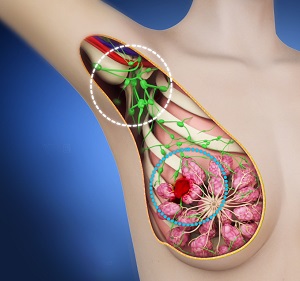
What is Axillary Surgery?
The removal of the lymph nodes in the armpit (axilla) is referred to as axillary surgery. It is performed to assess whether breast cancer has spread to other parts of your body. It may also involve the removal of lymph nodes that contain breast cancer cells.
Why is Axillary Surgery Performed?
The lymphatic system helps purify tissue fluids (lymph) and eliminate wastes. Lymph nodes present along the way act as filters for the lymphatic system. Cancer cells from a breast tumour can dislodge and spread through the lymphatic system. Breast cancer cells often get trapped in the axillary lymph nodes. Your doctor may choose to perform axillary surgery to remove lymph nodes affected by cancer or to see if cancer has spread. This helps determine the best course of treatment.
What are the Types of Axillary Surgery?
There are two types of axillary surgery:
- Sentinel lymph node biopsy
- Axillary lymph node dissection
What is a Sentinel Lymph Node Biopsy?
The sentinel lymph node is the first lymph node to filter lymph coming from the breast. This node has a high likelihood of having cancer cells if cancer has spread. The absence of cancer cells in these lymph nodes may indicate that cancer has not spread. Sentinel lymph node biopsy involves examining the tissue under a microscope and is recommended if you have early-stage breast cancer. It avoids the removal of a large number of lymph nodes and targets only a few lymph nodes to see if cancer has spread.
How is Axillary Surgery Performed to Remove the Sentinel Lymph Node?
During the procedure, a radioactive liquid along with a blue dye is injected around the site of the breast tumour. An instrument is then used to view the path along which the radioactive liquid or dye drains from the breast tissue and to identify the sentinel lymph node. The sentinel lymph node, and probably 1-2 adjacent lymph nodes, are then removed and evaluated.
If the sentinel lymph node biopsy is negative, your doctor will not recommend further axillary surgery. If the sentinel lymph node biopsy is positive, your doctor may recommend either radiation or mastectomy with axillary lymph node dissection.
What is Axillary Lymph Node Dissection?
Axillary lymph node dissection is a procedure to remove most of the lymph nodes in the underarm to control and assess the spread of breast cancer.
How is Axillary Surgery Performed for Lymph Node Dissection?
Axillary lymph node dissection usually takes about an hour to perform. You will be under general anaesthesia. Your doctor will make a 2-3-inch incision within a skin crease in your underarm.
Axillary surgery may be performed in conjunction with one of the following:
- Along with mastectomy (removal of the affected breast)
- Along with lumpectomy (removal of a part of the breast with cancer)
- After a lumpectomy
If a mastectomy is performed, axillary surgery is performed through the same incision. If a lumpectomy is performed, axillary surgery is performed through a separate incision.
The axillary lymph nodes are identified and most of the nodes are removed. About 5-30 lymph nodes may be removed depending on your anatomy and pathology. The excised lymph nodes are examined in the laboratory. The number of cancerous nodes determines the extent of cancer.
What are the Risks Associated with Axillary Surgery?
Following axillary surgery, you may experience:
- Loss of sensation in the underarm and at the back of the arm
- Abnormal sensations such as tingling and numbness in the arm
- Weakness of the arm
- Infection
- Lymphedema (swelling due to the accumulation of lymph)
- Inflammation of veins passing through the underarm
- Winging of the scapula
